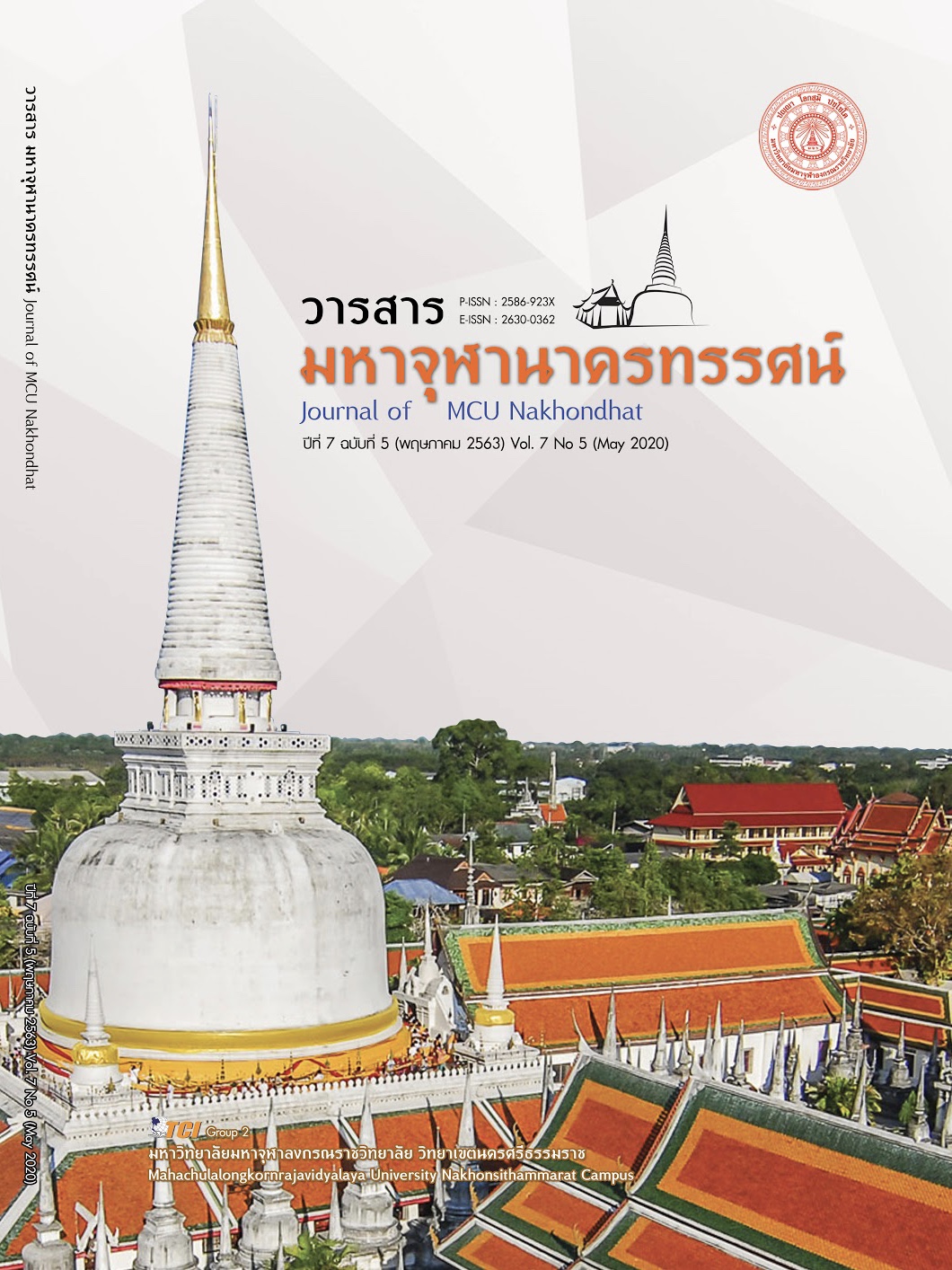การคบกันด้วยธาตุของคนในมิติพระพุทธศาสนา
Main Article Content
บทคัดย่อ
การคบค้าสมาคมของคนนั้น องค์สมเด็จพระสัมมาสัมพุทธเจ้าทรงพิจารณาเห็นว่า บุคคลทั้งหลายในโลกนี้ มักคบกันเพราะมีธาตุที่ตรงกัน คือ คนที่มีอุปนิสัยจิตใจตรงกัน คือ คนที่มีทัศนะหรือความเห็นตรงกัน เข้ากันได้ มีความประพฤติที่ตรงกัน หรือความประพฤติที่คล้ายคลึงกัน หรือใกล้เคียงกัน จึงจะมาสมคบ คบค้าสมาคมกัน ธาตุมีหน้าที่หรือกระบวนในการเชื่อมประสานและยึดเหนี่ยวสิ่งต่าง ๆ เหมือนกันกับจิตของสัตว์โลก ที่ทำการยึดเหนี่ยวและเชื่อมประสานทำให้เกิดความสมดุลทางด้านกายภาพและมโนภาพ ถ้าธาตุของคนไม่มีความสมดุลก็จะก่อให้ความแปรปรวนในร่างกาย ส่งผลกระทบต่อจิตใจ ทำให้อ่อนแรงและเกิดโรคต่าง ๆ ได้ เมื่อมีความแปรปรวนต้องค้นหาต้นเหตุเพื่อบำบัดให้ธาตุมีความสมดุลกัน จึงจะทำให้สุขภาพกายแข็งแรงและสุขภาพจิตสมบูรณ์สามารถดำรงชีวิตได้อย่างปกติสุข เพราะสรรพสิ่งทั้งหลาย คือธาตุ ไม่มีความมั่นคงถาวร มีความเสื่อมสภาพไปตามเวลาที่ผ่านไป และเมื่อถึงเวลาอันควร เหตุปัจจัยที่ทำให้ธาตุเหล่านั้นมาประชุมรวมกัน หมดไป ธาตุเหล่านี้ ก็จะแยกสลายกันไป จึงไม่ควรยึดมั่น ถือมั่นในสรรพสิ่งซึ่งที่มีสภาวะจะต้องแปร เปลี่ยนเป็นธรรมดา (ตถตา) ซึ่งตกอยู่ภายใต้กฎไตรลักษณ์ เมื่อบุคคลใดเข้าใจใน“ธาตุ” ทั้งที่เป็นรูปธรรมและธรรม ผู้นั้นสามารถเรียกได้ว่า “เป็นบัณฑิตผู้ฉลาดในธาตุ” เมื่อมองเห็นสรรพสิ่งต่าง ๆ ด้วยตาปัญญาตามความเป็นจริง จะทำให้สามารถดำเนินชีวิตได้อย่างมีความสุข และเป็นการเดินบนเส้นทางสู่มรรคผลนิพพาน หลุดพ้นวัฏสงสารได้
Article Details
เอกสารอ้างอิง
กฤติกาวลัย หิรัญสิ. (2554). ศึกษาความสอดคล้องของหลักการพยากรณ์ในคัมภีร์พระพุทธศาสนาเถรวาทและวิชาโหราศาสตร์ไทย. ใน วิทยานิพนธ์พุทธศาสตรมหาบัณฑิต สาขาพระพุทธศาสนา. มหาวิทยาลัยมหาจุฬาลงกรณราชวิทยาลัย.
ทีมบรรณาธิการพารามอน. (2549). ฟิสิกส์และเคมี = Essential atlas of physics and chemistry / ยิ่งศักดิ์ นิตยฤกษ์, ผู้แปล. กรุงเทพมหานคร: สุวีริยาสาส์น.
พร รัตนสุวรรณ. (2514). พุทธวิทยา เล่ม 1. กรุงเทพมหานคร: โรงพิมพ์มหาจุฬาลงกรณราชวิทยาลัย.
พระธรรมโกศาจารย์ (ประยูร ธมฺมจิตฺโต). (2540). วิทยาศาสตร์ในทรรศนะของพระพุทธศาสนา. (พิมพ์ครั้งที่ 2). กรุงเทพมหานคร: สหธรรมิก จำกัด.
พระพรหมคุณาภรณ์ (ป.อ.ปยุตฺโต). (2559). พจนานุกรมพุทธศาสตร์ ฉบับประมวลธรรม. (พิมพ์ครั้งที่ 34). กรุงเทพมหานคร: บริษัท เอส.อาร์ พริ้นติ้ง แมส โปรดักส์ จำกัด.
พระมหาสมจินต์ สมฺมาปญฺโญ. (2547). พระธาตุและพระบรมสารีริกธาตุกับคนไทย. กรุงเทพมหานคร: โรงพิมพ์มหาจุฬาลงกรณราชวิทยาลัย.
มหาจุฬาลงกรณราชวิทยาลัย. (2539). พระไตรปิฎกฉบับภาษาบาลี ฉบับมหาจุฬาลงกรณราชวิทยาลัย. กรุงเทพมหานคร: โรงพิมพ์มหาจุฬาลงกรณราชวิทยาลัย.
. (2539). พระไตรปิฎกภาษาไทยฉบับมหาจุฬาลงกรณราชวิทยาลัย. กรุงเทพมหานคร: โรงพิมพ์มหาจุฬาลงกรณราชวิทยาลัย.
มหามกุฎราชวิทยาลัย. (2548). อภิธัมมัตถสังคหบาลีและอภิธัมมัตถวิภานีฏีกา. (พิมพ์ครั้งที่ 7). กรุงเทพมหานคร: โรงพิมพ์มหามกุฎราชวิทยาลัย.
. (2549). มังคลัตถทีปนีแปล เล่ม 1. (พิมพ์ครั้งที่ 17). กรุงเทพมหานคร: โรงพิมพ์มหามกุฎราชวิทยาลัย.
ราชบัณฑิตยสถาน. (2546). พจนานุกรม ฉบับราชบัณฑิตยสถาน พ.ศ. 2542. กรุงเทพมหานคร: นานมีบุ๊คพับลิเคชั่นส์.


